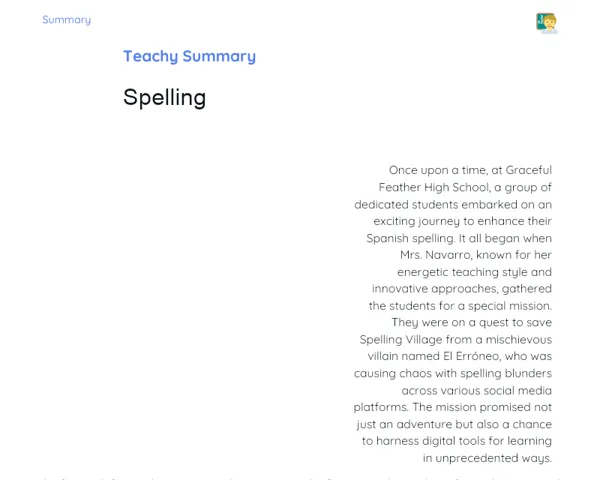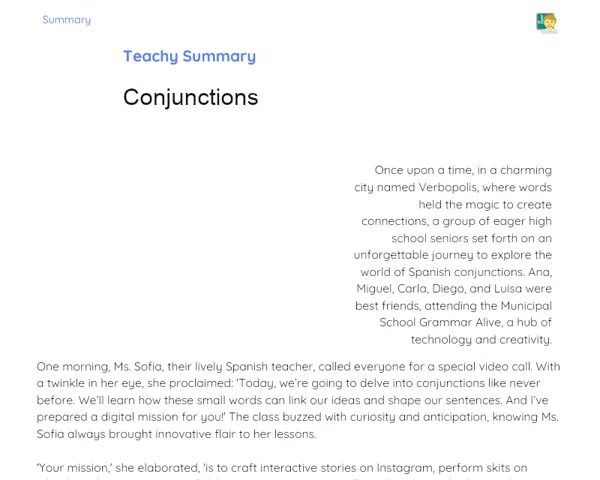Summary Tradisional | Muy vs. Mucho
Contextualization
In Spanish, the words muy and mucho are quite important as they serve different functions in sentences. Muy is used to intensify adjectives and adverbs, whereas mucho is used to quantify nouns and can work both as an adjective and an adverb. For example, we say 'Es muy inteligente' to underline someone's intelligence and 'Tiene mucho dinero' to indicate that someone has plenty of money. Using these words correctly is key to ensuring accuracy and clarity in Spanish communication.
Understanding the difference between muy and mucho might seem a bit tricky for learners, as using them incorrectly may change the meaning of a sentence and lead to misunderstanding. Also, note that muy is unchanging, while mucho adapts to gender (mucho/mucha) and number (muchos/muchas) when used as an adjective. This summary aims to clear these differences and give practical examples so that students can use muy and mucho correctly in various contexts.
To Remember!
Difference between Muy and Mucho
The distinction between muy and mucho is fundamental for forming precise sentences in Spanish. Muy is used to boost adjectives and adverbs, while mucho is used to quantify nouns, and it can act as either an adjective or an adverb. For instance, we use 'Es muy inteligente' to stress someone's intelligence, and 'Tiene mucho dinero' to show that someone possesses a great deal of money.
Furthermore, remember that muy remains unchanged irrespective of the gender or number; on the other hand, mucho changes form (mucho/mucha; muchos/muchas) when used as an adjective. When used as an adverb, however, it stays the same.
It is very important to apply these terms correctly for clear and precise communication. An error in their use can lead to a completely different meaning and cause confusion, which is why it is necessary to understand when and how each should be used.
-
Muy is used to intensify adjectives and adverbs.
-
Mucho is used to quantify nouns.
-
Muy is unvarying.
-
Mucho adjusts for gender and number when used as an adjective.
Uso de Muy
Muy is an unvarying word used to intensify adjectives and adverbs, meaning it does not change form regardless of the noun it accompanies. For example, we say 'Es muy alto' (He is very tall) and 'Ella está muy cansada' (She is very tired). In both cases, muy adds extra emphasis on the adjective.
Moreover, muy appears in many idiomatic expressions, making its proper use essential for fluent Spanish. Phrases like 'muy bien' (very well) and 'muy mal' (very badly) highlight how muy works to strengthen the meaning.
It is easy for students to remember that muy remains the same in every instance, simplifying its use in various contexts.
-
Muy is unchanging.
-
Muy intensifies adjectives and adverbs.
-
Muy is integral to many idiomatic expressions.
-
Muy helps to stress qualities and conditions.
Uso de Mucho
Mucho functions both as an adjective and an adverb. When used as an adjective, it changes form to match the gender (mucho/mucha) and number (muchos/muchas) of the noun it qualifies. For example, we say 'Tiene muchos amigos' (He has many friends) and 'Ella tiene mucha paciencia' (She has a lot of patience).
As an adverb, mucho stays the same and intensifies verbs, showing the extent of an action. For example, 'Corres mucho' (You run a lot) and 'Estudia mucho' (He/She studies a lot).
Additionally, mucho features in several idiomatic expressions such as 'mucho gusto' (nice to meet you) and 'mucho cuidado' (be very careful), which are commonly used in everyday conversation. Such expressions add a natural flow to communication.
-
Mucho changes for gender and number when used as an adjective.
-
Mucho is unchanging when used as an adverb.
-
Mucho is used to quantify nouns and intensify verbs.
-
Mucho figures in various idiomatic expressions.
Exceptions and Particularities
While the general guidelines for using muy and mucho are straightforward, there are a few exceptions to be aware of. For example, in some fixed expressions, mucho remains unaltered regardless of context – phrases like 'mucho gusto' (nice to meet you) and 'mucho cuidado' (be very careful) are typical examples.
Another interesting point is the use of muy before certain adverbs that indicate quantity, such as 'muy poco' (very little) and 'muy tarde' (very late); these combinations are common and can sometimes be confusing for learners.
It is also worth noting that usage can vary regionally, as different Spanish-speaking countries may adopt distinct idiomatic expressions or slang. This reinforces the need for regular practice and exposure to the language to achieve proficiency.
-
Mucho in fixed expressions does not change.
-
Muy is used before certain quantity adverbs.
-
Usage can differ based on cultural and regional context.
-
Regular practice is vital to master these exceptions.
Key Terms
-
Muy: Used to intensify adjectives and adverbs, unchanging.
-
Mucho: Used to quantify nouns and intensify verbs, changes for gender and number as an adjective.
-
Adjetivo: A word that describes a quality or characteristic of a noun.
-
Advérbio: A word that modifies a verb, adjective, or another adverb, indicating details such as manner, time, or place.
-
Substantivo: A word that names a being, object, place, or emotion.
-
Expressão idiomática: A phrase whose meaning isn’t directly deducible from the individual words.
Important Conclusions
In this lesson, we examined the key differences between muy and mucho. We saw that muy is used for intensifying adjectives and adverbs, while mucho is used to quantify nouns and can also act as an adverb. We noted that muy does not change its form, but mucho does when used as an adjective.
It is important to use these terms properly, as a wrong choice can alter the intended meaning of a sentence and lead to confusion. We reviewed several idiomatic expressions and practical examples to help illustrate the correct usage of these words in different contexts.
Mastering these words is essential for smooth and precise Spanish communication. It is highly recommended that students keep practising regularly to gain more confidence and proficiency. This lesson bridges theory with practice, laying a strong foundation for the correct use of muy and mucho.
Study Tips
-
Review the examples discussed in class regularly and try forming your own sentences using muy and mucho.
-
Watch Spanish films or serials and pay close attention to how these words are applied in various contexts.
-
Engage in grammar exercises to spot and correct any misuse of muy and mucho.



